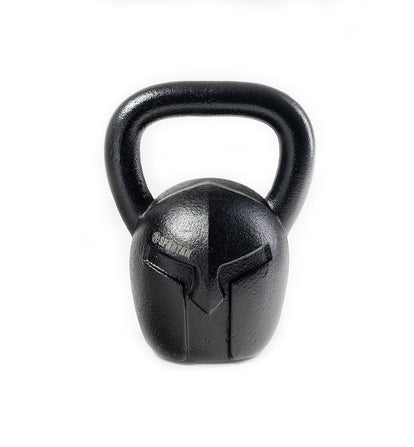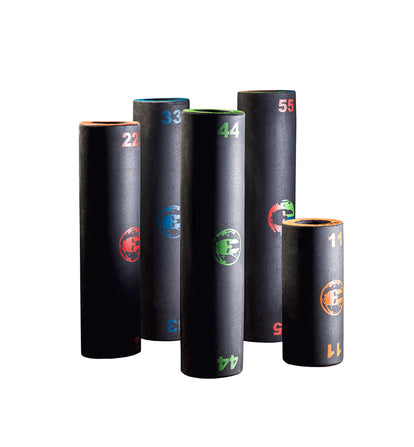Spartan Notes: What is Muscle Power & How Does it Affect Performance?

In Spartan Notes, a Spartan Fit franchise, we cut through the clutter to give you the most important need-to-know info on a particular subject. First up: muscle power.
The word “power” is thrown around a lot. “Anything that is measurable in wattage has a power output,” says Chris Hinshaw, a top endurance coach who has worked with more than 30 CrossFit Games champions. “Walking generates wattage, which is power. It's just a low level of power.” When elite athletes talk about power, they’re talking about something else: how fast they can move a load.
The confusion surrounding what power actually is, and how you can build it, means that many Spartans don’t focus on it, per Hinshaw. They work on strength, endurance, maybe even HIIT, but they’re lacking this critical piece of the well-rounded athlete puzzle. “Power is what helps you do things that require a high level of strength when you’re fatigued, like flipping tires, leaping over high hurdles, and exploding up walls in Spartan events,” says Hinshaw. Deliberately working on it can make racing both easier and faster. “There’s a huge opportunity here,” Hinshaw says.
Here, what you need to know about muscle power:

What is Power?
The definition of power is speed times strength, according to Hinshaw. If you’re weightlifting, it’s the load that you’re lifting combined with how fast you can move it.
Related: Power Workout: Lift Longer and Get Stronger
How is Power Different from Strength?
If you do a one rep max deadlift, you're building maximum strength. It’s a heavy, slow movement. “As a by-product of moving slow, you're going to be utilizing slow-twitch fibers to help you with that lift,” says Hinshaw.
But, if you drop that weight somewhere between 30 and 80 percent of your one rep lift, now you’re training power because you're able to move that bar faster. (Lifting in the 20 to 30 percent range would actually be training maximal speed, which is a whole different story!) “Power has velocity and when you have velocity, it now targets primarily fast-twitch fibers, which generate five times the power of a slow-twitch fiber.”
Why is Power Important?
What you’re really doing when training for power is outsmarting the brain, says Hinshaw. “The brain only wants to give you the bare minimum of muscle fibers needed to do a certain task — it always wants to save something in reserve. By doing high-power movements, the brain is forced to recruit more fibers, therefore sending the signal to the muscles to move quicker. That improves reaction time.”
Your metabolic rate is elevated for hours after these workouts, too. “Essentially what you're doing is utilizing fat at a much higher rate,” says Hinshaw.

What Are the Different Types of Power?
Olympic Lifts
As mentioned above, lifting between 30 to 80 percent of your 1RM can qualify as power training.
Hill Sprints
Compared to sprinting on flat ground, uphill running is more power-based because it requires strength to run up the hill. (And we know that speed x strength = power.) Try 6 sets of 10-second uphill sprints with 3 minutes of recovery between each.
Plyometrics
A plyometric could be considered power — if you’re doing them right. Let’s look at a 20-inch box jump. “If you jump up and step down 50 times, that's really just general fitness,” says Hinshaw. “But, if you jump up on the box and you get your balance, jump down to the ground, and then react as quickly as possible, and jump back up on top of the box, that's a plyometric.” You're training a quick reaction time: how fast can you get off the ground and back up on the box?
Ballistics
Let’s do those box jumps again, but this time with a pair of dumbbells held at your sides. That’s a ballistic, and it is a true power-based movement. “If I give you two 50-pound dumbbells and say, ‘Okay, now make the jump,’ there's an element of risk. So instead of getting a bare minimum of muscle fibers to make the jump, your brain will give you a maximum recruitment,” Hinshaw explains. Rather than training 50 percent of your recruitment by doing bodyweight box jumps, you’re going to train 80 percent.
Try 5 sets of 6 to 10 sumo deadlifts to high pull (with the Spartan Kettlebell) followed by 45 seconds of sumo deadlift high pulls with a PVC pipe.
Related: The 5 Spartan Rules to Master Your Kettlebell Workouts
Or, try 5 sets of 6 to 10 reps of ground to overhead with a plate (or the Spartan RAMroller) followed by 45 seconds ground to overhead with a PVC pipe.
How Often Do I Need to Train for Power?
At a minimum, Hinshaw recommends once a week. But if you really want to maximize this important aspect of fitness — let’s say you're an endurance athlete and you don't have a finishing kick — then you need to be doing this two to three times per week. The good news is that it’s not a huge investment of time. Three to five minutes is all it takes.
One other note: Variety creates a broader range of adaptation, and ensures that your brain and muscles never fully adapt to one particular thing, so they’re always improving. That means you’ll want to run at different speeds (think: fast, faster, and fastest) and switch up the ballistics you’re doing on the regular (this week: sumo deadlifts, next week: weighted box jumps).














